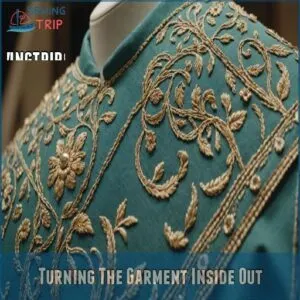This site is supported by our readers. We may earn a commission, at no cost to you, if you purchase through links.

First, cut a patch slightly larger than the hole.
Trim away any frayed edges so you’re not starting on shaky ground.
Flip your jeans inside out, pin the patch over the hole, and stitch it in place.
If sewing isn’t your cup of tea, fabric mending tape can do the trick!
Trim the excess and voilà, your jeans are as good as new.
Plus, choosing funky fabrics can turn a tear into a trendy statement piece.
Stay tuned for the scoop on personalizing your perfect patch job!
Table Of Contents
- Key Takeaways
- Causes of Stretch Marks in Denim
- Patching Jeans With Fabric for Stretch Marks
- Preparation for Patching Jeans
- Hand-Sewing Fabric Patches on Jeans
- Machine-Sewing Fabric Patches on Jeans
- Tips for Applying Fabric Patches Over Holes
- Creating DIY Fabric Patches for Jeans
- Placement and Considerations for Fabric Patches
- Repairing and Preventing Future Stretch Marks
- Tailoring Services for Denim Repair
- Frequently Asked Questions (FAQs)
- Conclusion
Key Takeaways
- Cut your fabric patch slightly larger than the hole, remove any frayed edges, and pin it securely from the inside of your jeans before stitching.
- Choose the patch type and location strategically, such as cotton for knees or denim for back pockets, to ensure durability and style.
- Use sewing techniques like straight stitching or explore no-sew options like fabric mending tape for quick and effective patching.
- Maintain your jeans by washing them in cold water, avoiding fabric softeners, and air drying to prevent further damage and keep them looking sharp.
Causes of Stretch Marks in Denim
When your favorite jeans suddenly develop stretch marks, it can feel like betrayal, but it’s usually due to fabric stretch and weave, along with your laundry habits.
Poor denim quality can also speed up this process, giving your jeans an unplanned makeover.
Fabric Stretch and Weave
Recognizing how denim types impact stretch marks is key.
Skinny jeans, with their unique weave patterns and high fabric elasticity, often show more puckering.
Yet, a good stretch recovery can save the day.
Opt for denim with substantial weight for better durability.
It’s like finding that balance between comfy elasticity and holding shape through daily wear.
Washing and Drying Practices
Keeping your jeans looking sharp means being smart about washing and drying.
Opt for cold water to preserve elasticity and skip fabric softeners—they can weaken those stretchy threads.
Using harsh detergents and intense heat, as seen in cases of fabric stretching damage, can also harm your jeans.
Use mild detergent, and dry them flat instead of in the dryer.
Save high heat for toast, not denim.
Washing less frequently also helps keep your jeans in top form.
Denim Quality and Maintenance
With better denim, you’re investing in a longer denim lifespan.
Higher-quality denim, like raw denim or vintage denim, often resists stretch marks better.
But even the best jeans need TLC!
- Check those care label secrets – they’re your denim’s best friend.
- Cold washes are your new best friend.
- Avoid harsh detergents; they’re denim’s enemy.
- Air drying helps preserve those awesome denim fades.
- Proper storage keeps your jeans looking their best.
Patching Jeans With Fabric for Stretch Marks
When you’re thinking about patching jeans with fabric for stretch marks, you might feel like you’re fighting an uphill battle, but fear not, you’ve got this.
Here’s a quick breakdown to guide you through: Using hand sewing techniques for jeans, you can add a unique touch with embroidery stitches and reinforce small holes or tears with fusible interfacing.
| Fabric Patch Types | Patch Placement |
|---|---|
| Cotton | Knee or Thigh Areas |
| Denim | Back Pockets |
| Canvas | Inner Thighs |
| Leather | Ankle Cuffs |
| Embroidered | Front Pockets |
Fabric types vary; choose one that complements your jeans.
Placement can make or break the look, so think strategically—outer appearances matter!
Make sure patches are durable by using good-quality materials.
Remember, patching is an art, much like painting over a blank canvas—get creative with DIY patch ideas and prevent stretch marks from reappearing with a little TLC.
Preparation for Patching Jeans
Get your patching project off to a great start by gathering materials like thread, scissors, and fabric patches.
Prepare the damaged area of your jeans by cleaning it and removing any frayed threads.
Gathering Materials and Tools
Getting ready to patch jeans? Start with gathering materials and tools like a pro. Here’s your quick list:
- Measuring Tape: Precise measurements help your patch fit perfectly without any hitch.
- Sewing Kit: Needles, thread, and a thimble are your trusty sidekicks.
- Scissors: Sharp ones keep the fabric edges clean, avoiding any loose threads.
Choosing The Right Fabric Patch
Picture yourself picking the perfect patch, prioritizing fabric type and color match. It’s like finding the ideal puzzle piece.
Patch size matters: big enough to cover, small enough to blend in.
Look for similar texture and durability to your jeans.
A mismatched patch is a clumsy sidekick, while the right one feels like magic.
Preparing The Damaged Area
You’ve chosen your patch; now let’s get the jeans ready.
Start by cleaning the damaged area to remove any dirt.
Measure and mark the section around the stretch mark using chalk for precision.
Next, a quick run-over with an iron will flatten the fabric.
This prep makes sure the patch is secure, sticking to dimensions and avoiding pesky wrinkles.
Hand-Sewing Fabric Patches on Jeans
Hand-sewing a fabric patch on your jeans allows you to customize and repair them with ease. Alternatively, you can use a no-sew adhesive like Speed Sew for fabric repairs to quickly fix tears and holes, especially for minor repairs. Hand-sewing a fabric patch on your jeans allows you to customize and repair them with ease.
Follow these steps to secure your patch effectively, ensuring your jeans look stylish and sturdy.
Positioning The Patch
Before sewing, carefully position your patch.
Accurate patch placement is key!
Consider patch shape and size relative to the damaged area.
Align the patch with existing seams for a seamless look.
A little planning goes a long way.
Pinning it securely prevents shifting during stitching.
Now you’re ready to thread your needle.
Threading The Needle
Got your patch positioned? Now it’s time to thread your needle!
- Choose a needle: Go for a sharp type suited for denim.
- Pick your thread: Make sure the thickness matches your fabric.
- Knot like a pro: Double knot at the end to keep it secure.
With these steps, you’re sewing like a seasoned tailor!
Sewing a Straight Stitch
Mastering a straight stitch is key when hand-sewing patches.
Opt for a short stitch length to guarantee durability and even coverage.
Keep an eye on your needle size and thread tension for a smooth finish.
Imagine it like drawing a line—steady and straight, but with the freedom to adjust.
Remember, practice makes perfect, and your jeans will thank you!
Securing The Patch
Once you’ve got your straight stitch in place, it’s time to make sure your patch stays put.
Knot security is key—tie a snug double knot to secure it.
Consider the thread tension; it should be tight enough to hold without puckering.
Check the patch placement as you finish, making sure everything lays flat.
You’re set with sewing techniques that last!
Machine-Sewing Fabric Patches on Jeans
When machine-sewing fabric patches on jeans, choose thread that matches your patch or blends well to maintain style.
Backstitch for extra durability.
Consider turning the garment inside out for easier sewing.
Selecting The Right Thread Color
Choosing the right thread color is like picking the perfect tie for an outfit—it pulls everything together.
Aim for thread color matching or a color contrast that complements your denim.
Blending thread makes for a seamless look, while thread thickness and durability keep your patch lasting long.
It’s all about finding that sweet spot of harmony and strength.
Backstitching for Durability
In sewing, durability is king, especially with backstitching.
When machine-sewing patches on jeans, use a backstitch guide for precise stitching, and follow these key steps:
- Backstitch length: Keep it short for strength.
- Stitch tension: Adjust for smooth flow.
- Thread type: Match the denim weight.
- Machine settings: Balance for heavy fabric.
A good backstitch makes sure your patch withstands everyday wear and tear.
Turning The Garment Inside Out
Before sewing, flip your jeans inside out.
This move may require some tricks to turn narrow straps or tubes right side out, like using safety pins for turning.
This clever move hides your stitches, giving your patch a professional, clean look.
It’s like a magic trick – poof! No more visible seams.
Now you’re ready to sew, ensuring a neat finish and a durable patch.
Remember to check your seam allowance!
Tips for Applying Fabric Patches Over Holes
When patching jeans, make sure your patch fits snugly over the hole by trimming any frayed edges and treating them with fabric glue.
To securely attach your fabric patch, consider using a suitable adhesive by checking fabric compatibility. Pin the patch securely in place to keep it steady while you work.
Ensuring a Secure Fit
A snug patch fit makes your jeans look sharp, like they just left the tailor’s bench.
Patch size matters–go slightly larger than the hole, extending at least 1 inch beyond the damaged area for reduced tension, as seen in techniques for fixing knee holes in pants.
Choose a patch with a similar fabric weight for balance.
Adjust your thread tension so stitches hold firm but aren’t too tight.
Proper patch placement helps keep everything in line, letting your jeans live on.
Trimming Frayed Edges
Now that you’ve secured the patch, grab your fabric scissors and slice through those frayed edges.
It’s like giving your jeans a sharp haircut—they’ll look neater and feel smoother.
Aim for neat trims with clean cuts, ensuring each edge meets the fabric smoothly.
Using sharp blades makes this a breeze, preventing further unraveling while prepping your patch perfectly.
Treating The Hole Edges
Think of treating hole edges like prepping a wound to prevent fraying. You wouldn’t just slap a bandage on, right? Here’s the lowdown:
- Snip loose threads gently to clean up the area.
- Fabric glue can help seal the edges.
- No-fray options offer added protection.
- Make sure the edges are tidy to prevent further damage.
Pinning The Patch in Place
When pinning the patch in place, use just the right-sized pins to hold it securely.
Don’t use too many—you want the fabric to breathe, like a good cup of coffee, sweet but not overwhelming.
Check out this quick table for details:
| Aspect | Tips |
|---|---|
| Pin Size | Use medium pins |
| Pin Types | Straight, secure |
| Spacing | 2 inches apart |
| Techniques | Pin from center |
| Safety | Avoid sharp pins |
Creating DIY Fabric Patches for Jeans
When you’re ready to personalize your jeans, creating DIY fabric patches is a creative and practical way to start.
You’ll learn techniques like hand-embroidering, using stylish cross-stitch patterns, and even employing simple shapes inspired by emojis for a fun finishing touch.
Hand-Embroidering Designs
Ready to express your inner artist? Creating custom patches is easier than you think! Hand-embroidery lets you personalize your jeans. Here’s how:
- Choose an embroidery stitch guide.
- Select your embroidery thread types.
- Grab the right embroidery needle sizes.
- Sketch your embroidery pattern ideas. Get creative!
Utilizing GIFs and Emojis for Inspiration
Jumping from needle work to digital creativity, emoji inspiration or GIF art can spice up your DIY patch design.
Think of these visual ideas as a playful touch to your creative design, reflecting your mood.
For those who need more inspiration or want to purchase pre-made emoji patches, you can find a variety of emoji patch jeans at emoji patch jeans online.
Here’s a quick guide:
| Emoji | Feeling | Idea | Design Tip |
|---|---|---|---|
| | Happy | Smile Patch | Use bright colors |
| | Artsy | Paint Splash | Abstract shapes |
| | Nature | Leaf Motif | Earthy tones |
| | Adventurous | Space Design | Metallic threads |
Cross-Stitching Techniques
Cross-stitching on jeans isn’t just crafty—it’s a creative game-changer.
Grab some embroidery floss and let these ideas kickstart your patch project:
- Cross-Stitch Patterns: Explore simple geometric shapes or trendy motifs.
- Color Palettes: Choose bright or subtle hues to make your patch pop.
- Fabric Choices: Select sturdy materials to anchor your design beautifully.
Employing Stamps for Shapes
Want to add unique flair to your jeans?
Stamps can help with that.
Choose rubber stamps with interesting designs — hearts, stars, or quirky patterns.
When choosing a fabric paint, consider using a set like the best fabric paint for denim that offers vibrant, non-toxic colors and a satin finish. Pick a fabric paint that works with your denim.
Lightly press the stamp onto the fabric, ensuring even coverage.
Creativity meets practicality with these DIY patch tips.
Let your imagination run wild!
Placement and Considerations for Fabric Patches
When you patch jeans, think about where you place the patch to get the best look and function.
Whether you’re covering a hole or adding a decorative touch, consider the patch’s size, color, and impact on the overall style.
Uniform Patches and Regulations
Thinking about DIY patches? Before you jump in, if you’re dealing with uniform patches, it’s key to follow the playbook.
Patch placement isn’t just about looks; it’s a rulebook game.
Check for size requirements and get them from authorized vendors.
Removing patches requires patience—don’t rush it, or you might find yourself with more than one problem.
Concealing Holes and Stitches
When you’re patching a hole in your jeans, cleverly concealing stitches is an art.
Consider matching your patch materials and designs with your jean’s aesthetic, just like you’d when learning how to sew a patch onto a jacket, to keep them looking sharp.
Position your patch just right so it hides the hole completely, maintaining your jean’s look.
With some DIY magic, your jeans will look—and feel—like a patch-up pro handled them.
Decorative Patches and Aesthetics
So, you’ve covered up those holes. Now, let’s talk patch style!
Patch placement is key; think about the overall look.
A small, simple patch might work for a subtle touch, while a larger, more elaborate one can be a statement piece.
Consider the patch size relative to the garment, or browse for inspiration among various Jeans Patches designs.
You want it to look intentional, not an afterthought.
Experiment and have fun!
Color and Overall Look
Choosing the right patch color can make or break your denim’s style.
Match the patch with the denim shade for a cohesive look, or go bold for a striking contrast.
Think about patch placement—strategically placed patches enhance visual appeal while maintaining overall style.
Mixing textures and colors allows you to personalize and refresh your favorite jeans creatively.
Repairing and Preventing Future Stretch Marks
Repairing and preventing stretch marks in your jeans involves simple techniques like steaming or using fabric adhesives to bond fibers.
Proper denim care, such as washing in cold water and avoiding high heat, can also help preserve your jeans’ fabric and keep stretch marks at bay.
Steaming and Ironing Minor Stretch Marks
To tackle minor stretch marks, start by gently steaming the jeans to relax the fabric.
Use a garment steamer or hang them in a steamy bathroom.
After that, lightly iron on a low heat setting, smoothing out uneven areas.
This helps reduce visible marks and adds a fresh feel.
Opt for a cotton cloth to protect delicate fabric types from direct heat.
Using Fabric Adhesives for Bonding Fibers
While steaming smooths minor stretch marks, fabric adhesives come to the rescue for more stubborn cases.
Fabric adhesives should be sturdy and suitable for your fabric type.
Apply a thin layer, pressing gently to bond fibers effectively.
Stick with these tips, and you might just find your jeans ready to face their next adventure without any durability concerns.
Reweaving Damaged Areas
Reweaving damaged areas in jeans is like stitching magic back into the fabric. It’s a way to make denim look as good as new without drastic measures.
- Reweaving techniques can seamlessly conceal flaws.
- Reweaving for denim requires a skilled hand for finesse.
- Professional reweaving guarantees precision.
- Consider the cost of reweaving for valuable jeans.
- Use reweaving tools for best results.
Washing and Caring for Denim
Professional reweaving’s a great last resort, but let’s face it, preventing damage is easier.
Cold water washes are your denim’s best friend; they keep those colors vibrant and prevent stretching.
Avoid the dryer—air drying is gentler.
Don’t overdo the washing; less is more.
A little stain remover goes a long way, too.
Following these simple steps keeps your jeans looking great, and that’s a win-win.
Tailoring Services for Denim Repair
When your favorite jeans need more than DIY fixes, tailoring services offer professional denim repair.
From adjusting waistbands to replacing zippers, experienced tailors can restore your jeans to their former glory.
Necklines and Zippers
Think of zippers and necklines as the unsung heroes of denim repair.
Need a zipper moved or repaired?
Some tailors can shift it for easier access or replace it with a different type.
Adjusting necklines, like transforming a basic V-neck into something more stylish, can refresh old jeans, opening a world of style possibilities.
Size Adjustments and Waistbands
When your jeans’ gapping waistbands make you feel like you’re wearing a parachute, a tailor’s magic can give them a snug fit.
For a more thorough repair, learning how to sew a tear can be a game-changer for extending the life of your jeans. Waistband alterations and size reductions are quick fixes for better jeans fitting.
Most tailors recommend taking pants in by up to two inches—any more risks the design.
Enjoy the newfound freedom and confidence!
Lining and Sheer Fabrics
You’ve pondered sheer fabrics in denim and lining can be your answer.
Here’s why lining works wonders:
- Increases opacity: No more see-through worries.
- Boosts comfort: Smooth against the skin.
- Enhances durability: Extra layer equals strength.
- Adds style: Creates unique fashion layers.
- Flexibility in choice: From cotton to silk, pick your lining fabric.
Sheer fabric care has never been so easy!
Shoulder Adjustments and Limitations
Adjusting denim shoulders can be tricky.
Often, it involves rebuilding the garment, so watch out for cost factors!
Here’s a quick peek:
| Adjustment Type | Feasibility |
|---|---|
| Shoulder Seams | Slightly doable |
| Fabric Type | Important |
| Garment Style | Matters |
| Cost Factor | High |
| Professional Advice | Advised |
Trust professionals for shoulder seams on your favorite jeans!
Frequently Asked Questions (FAQs)
How to put patches on jeans?
Adding patches to jeans is like opening a canvas of creativity.
Patches can be positioned, pinned, and stitched securely with a strong thread.
Use an embroidery needle for precision, bringing old jeans back to life with flair.
Do patches make jeans look better?
Patches can definitely give your jeans a unique flair and personality.
Whether you’re covering up holes or just adding style, they offer a creative touch that can transform basic denim into a standout piece of your wardrobe.
Should you use a lot of patches on a jean dress?
Using a lot of patches on a jean dress can be stylish, but balance is key.
Too many can overpower the look; instead, aim for a few strategic placements to enhance the dress without overwhelming it.
How do you sew fusible patches on jeans?
Think of fusible patches as your jeans’ secret weapon against wear.
Simply place the adhesive side down on the patch area, cover with a cloth, and apply a hot iron until it bonds.
Test for adhesion.
What if you didn’t have a patch on your jeans?
You don’t need a patch to fix jeans.
Try using fabric glue or sewing the edges together for a subtle repair.
Alternatively, embrace the distressed look and let the tear add character to your jeans.
How do you put a patch on a jacket without sewing?
Grab some fabric adhesive and a cool patch.
Clean the jacket surface, apply the adhesive on the patch’s back, and firmly press it onto the jacket.
Let it dry completely, and you’re set for style!
How to add fabric patches to jeans?
Want to add some personality to your jeans? Choose a cool patch, position it where you want it, and sew it on! It’s that easy. You’ll love the results.
How do you neatly patch jeans?
Just like mending a friendship, patching jeans requires patience and precision.
Attach your patch from the inside, securing it with small, neat stitches.
This way, you seamlessly blend the repair, conserving the jeans’ original charm.
How to patch up ripped jeans?
To patch ripped jeans, pick a matching fabric, cut it slightly larger than the rip, and secure it inside with fabric glue or stitches.
For best results, sew around the patch edges for durability.
How to put a patch on jeans without sewing?
Explore the no-sew patch myth!
For a seamless repair, consider choosing a patch material that blends seamlessly. Use fabric adhesive or iron-on patches for a quick fix.
Cut your patch, apply adhesive, and press firmly.
Iron-on needs heat; place a cloth over it and iron gently.
Can I use iron-on patches?
Yes, you can use iron-on patches for jeans!
They’re easy to apply: just position the patch, cover with a cloth, and press with a hot iron.
When repairing torn jeans, you can use a technique such as the flat felled seam for heavy-duty repair. This quick fix adds flair without needing sewing skills.
What type of needle should I use?
When patching jeans, use a sharp needle suitable for denim, like a size 90/14 or 100/
These needles are sturdy enough to handle thick fabric without bending.
This ensures your patch stays securely attached.
How do I choose patch fabric?
Pick a patch fabric that’s thick and durable, like denim or canvas.
Match the color closely to your jeans or go bold for a pop of personality.
Make sure it’s slightly larger than the hole for secure coverage.
Where can I find unique patches?
Find unique patches at fabric stores, craft markets, or even online. Thrift stores and vintage shops are also treasure troves. Don’t be afraid to get crafty and make your own!
How do I prevent fraying edges?
Seal fraying edges with fabric glue or no-fray spray for a clean finish.
You can also fold and stitch to encase the raw edge, or use zigzag stitches to reinforce and prevent further fraying.
Conclusion
Did you know that nearly 85% of jeans wearers deal with rips and tears over time?
Embracing these imperfections by learning how to patch jeans with fabric transforms ordinary denim into unique, statement pieces.
Whether you choose sewing or fabric mending tape, patching jeans gives them renewed life and style.
By following simple steps—preparing the area, cutting the right patch, and securing it—you’ll soon master this fun and practical DIY skill, ensuring your jeans last longer.




















